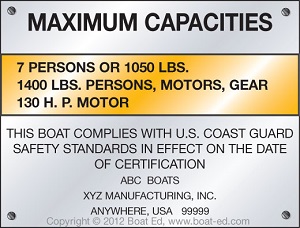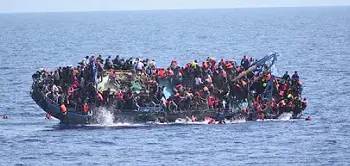What is the best way to avoid overloading your boat? First of all, you must not load more than your boat can handle. Second, The weight must be distributed evenly so that the boat does not go out of balance.
As boat enthusiasts, we know that your day on the water is only as good as your captain’s. You need a knowledgeable and experienced guide to take you through all of the different waterways. But sometimes, even with an experienced captain at the helm, things can go wrong. For example, if you overload your boat by adding too many people or too much gear on board then it will sink like a stone in still waters. So what is the way to avoid overloading? Keep reading below.

What is the best way to avoid overloading your boat?
Follow capacity plate
Follow what is written on the capacity plate. If it says it can carry 100kg then you shouldn’t add extra weight or passengers up to a maximum of 160kg. The capacity plate will usually tell you what it can carry for certain distances. For example, what weight it can carry when stationary in calm conditions and what weight it can carry when moving slowly in windy or rough waters.

The capacity plate is usually located on the stern or the side of your boat. It is normally attached to the boat registration plate. How did this capacity plate come about? Some states legally require boat owners to adhere to what is written on their capacity plate. This shows what weight it can carry safely with what speed and what load your engine will be able to cope with.
Calculate boat capacity formula
If you are going to do any traveling then it is a good idea to calculate what your boat’s capacity is. You can use the following formula:
Number of passengers (N) = boat length (L) x boat width (B)/ 15
This means that the number of passengers you can carry to avoid overloading your boat is equal to (length x width) divided by 15. All you have to do is multiply the length of your boat (in feet) by its width (in feet) and then divide this number by 15. This will tell you how many people can comfortably sit on the boat without risking overloading your boat.
NMMA certification
National Marine Manufacturers Association certification is what you should be looking for when you are buying a boat. It will tell you what the maximum capacity is for your boat. This means that the boats have been tested and they fall within what is considered safe speed limits, maximum passenger numbers, and what weight they can carry safely.
Avoid max weight capacity
You should learn what your boat’s weight capacity is before you head off. This will help to keep you and your passengers safe on the water. If you exceed what the boat can carry correctly then it won’t be able to handle what is put upon it. It might also sink if too much cargo, gear, or people are added whilst out on a trip.
Don’t overload your boat with passengers
When you are out on the water what matters is comfort. If you have too many people on board then it won’t be comfortable for anyone. You can also risk capsizing and even sinking if everyone weighs more than what the boat can hold safely.
If you need to carry extra passengers then what you should do instead is increase the size of the boat. You can add a second boat, a motorboat, or a sailboat for example. This will prevent the craft from capsizing if it doesn’t carry what it says on its capacity plate.
Distribute weight evenly
If you are going to carry little extra passengers then what you should do is distribute the weight evenly. You shouldn’t load one side of your boat more than what the other side can handle. This will help to ensure that it doesn’t tip over, capsize or sink at sea.

You should also remember what you have added to your boat when it is fully loaded. You shouldn’t be taking any unnecessary equipment or items with you if what is added will overload your boat. This means that what you carry should serve a purpose and it should not go overboard.
Planning a trip in bad weather
You should remember what your boat can carry when you are out on the water on a day that is bad weather. For example, what it can hold for certain speeds and what it can handle rough winds or choppy waters. If the weather changes while you are out at sea then you should reduce the number of passengers onboard, what speed you are traveling at, and what gear you have brought with you. This will help to reduce the chances of capsizing or sinking in choppy waters or if it is too windy for your boat’s stability and weight capacity.
Overpower the boat
You should carefully consider what boat and engine combination you want to use for what trip. You shouldn’t just put the largest engine and most powerful motor on your craft if what it can take is a smaller one. Using an overpowered motor or outboard also has a bigger risk of capsizing than you should assume.
Do Not Forget what the Capacity Plate Says. If you do forget what your boat’s capacity plate says and what weight it can carry then what you should do is simply read it again.
Conclusion
Don’t let your boat sink like the Titanic. You may not have noticed, but you’re too heavy for your vessel and it’s about to break from the strain. With a little bit of foresight, you can avoid this issue before it becomes an expensive problem by following these simple guidelines: stay below your boat’s max weight capacity; do not take extra passengers on board; distribute weight evenly across all compartments; avoid transporting heavy loads in bad weather, and don’t overload your engine. What is the best way to avoid overloading your boat? By taking care now, while there’s still time.

